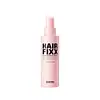What's inside
What's inside
 Key Ingredients
Key Ingredients

 Benefits
Benefits

 Concerns
Concerns

 Ingredients Side-by-side
Ingredients Side-by-side

Water
Skin ConditioningPvp
Emulsion StabilisingButylene Glycol
HumectantPhenoxyethanol
PreservativeHydroxyacetophenone
AntioxidantPEG-60 Hydrogenated Castor Oil
EmulsifyingDimethicone PEG-7 Phosphate
CleansingPolyglyceryl-2 Oleate
EmulsifyingOctyldodeceth-16
EmulsifyingGlycerin
HumectantCaprylyl Glycol
EmollientC12-14 Alketh-12
EmulsifyingSodium Citrate
BufferingEthylhexylglycerin
Skin ConditioningCitric Acid
BufferingCeramide AP
Skin Conditioning1,2-Hexanediol
Skin ConditioningCryptomeria Japonica Leaf Extract
HumectantNelumbo Nucifera Leaf Extract
Skin ConditioningSaccharomyces Ferment
Skin ConditioningMentha Rotundifolia Leaf Extract
TonicCamellia Sinensis Leaf Extract
AntimicrobialThymus Vulgaris Leaf Extract
Skin ProtectingTocopherol
AntioxidantAmp-Acrylates/Allyl Methacrylate Copolymer
Vinyldimethicone
Copernicia Cerifera Wax
Ceteareth-20
CleansingLecithin
EmollientSteareth-100
Gel FormingHexylene Glycol
EmulsifyingWater, Pvp, Butylene Glycol, Phenoxyethanol, Hydroxyacetophenone, PEG-60 Hydrogenated Castor Oil, Dimethicone PEG-7 Phosphate, Polyglyceryl-2 Oleate, Octyldodeceth-16, Glycerin, Caprylyl Glycol, C12-14 Alketh-12, Sodium Citrate, Ethylhexylglycerin, Citric Acid, Ceramide AP, 1,2-Hexanediol, Cryptomeria Japonica Leaf Extract, Nelumbo Nucifera Leaf Extract, Saccharomyces Ferment, Mentha Rotundifolia Leaf Extract, Camellia Sinensis Leaf Extract, Thymus Vulgaris Leaf Extract, Tocopherol, Amp-Acrylates/Allyl Methacrylate Copolymer, Vinyldimethicone, Copernicia Cerifera Wax, Ceteareth-20, Lecithin, Steareth-100, Hexylene Glycol
Alcohol Denat.
AntimicrobialWater
Skin ConditioningButylene Glycol
HumectantOctylacrylamide/Acrylates/Butylaminoethyl Methacrylate Copolymer
PEG-60 Hydrogenated Castor Oil
EmulsifyingParfum
MaskingTromethamine
BufferingAminomethyl Propanol
BufferingVp/Methacrylamide/Vinyl Imidazole Copolymer
Menthol
MaskingGlycerin
HumectantSalicylic Acid
MaskingPanthenol
Skin ConditioningCaprylic/Capric Triglyceride
MaskingHydrogenated Lecithin
EmulsifyingGlycine Soja Seed Extract
Skin Conditioning1,2-Hexanediol
Skin ConditioningCeramide NP
Skin ConditioningPentylene Glycol
Skin ConditioningOctanediol
Cynanchum Atratum Extract
Skin ConditioningEthylhexylglycerin
Skin ConditioningAlthaea Rosea Flower Extract
Skin ConditioningHydrolyzed Collagen
EmollientHydrolyzed Keratin
HumectantCyclohexasiloxane
EmollientArgania Spinosa Kernel Oil
EmollientBiotin
AntiseborrhoeicMoringa Oleifera Seed Oil
EmollientCentella Asiatica Extract
CleansingSilk Amino Acids
HumectantHydrolyzed Elastin
EmollientTocopherol
AntioxidantAlcohol Denat., Water, Butylene Glycol, Octylacrylamide/Acrylates/Butylaminoethyl Methacrylate Copolymer, PEG-60 Hydrogenated Castor Oil, Parfum, Tromethamine, Aminomethyl Propanol, Vp/Methacrylamide/Vinyl Imidazole Copolymer, Menthol, Glycerin, Salicylic Acid, Panthenol, Caprylic/Capric Triglyceride, Hydrogenated Lecithin, Glycine Soja Seed Extract, 1,2-Hexanediol, Ceramide NP, Pentylene Glycol, Octanediol, Cynanchum Atratum Extract, Ethylhexylglycerin, Althaea Rosea Flower Extract, Hydrolyzed Collagen, Hydrolyzed Keratin, Cyclohexasiloxane, Argania Spinosa Kernel Oil, Biotin, Moringa Oleifera Seed Oil, Centella Asiatica Extract, Silk Amino Acids, Hydrolyzed Elastin, Tocopherol
Ingredients Explained
These ingredients are found in both products.
Ingredients higher up in an ingredient list are typically present in a larger amount.
1,2-Hexanediol is a synthetic liquid and another multi-functional powerhouse.
It is a:
- Humectant, drawing moisture into the skin
- Emollient, helping to soften skin
- Solvent, dispersing and stabilizing formulas
- Preservative booster, enhancing the antimicrobial activity of other preservatives
Butylene Glycol (or BG) is used within cosmetic products for a few different reasons:
Overall, Butylene Glycol is a safe and well-rounded ingredient that works well with other ingredients.
Though this ingredient works well with most skin types, some people with sensitive skin may experience a reaction such as allergic rashes, closed comedones, or itchiness.
Learn more about Butylene GlycolEthylhexylglycerin (we can't pronounce this either) is commonly used as a preservative and skin softener. It is derived from glyceryl.
You might see Ethylhexylglycerin often paired with other preservatives such as phenoxyethanol. Ethylhexylglycerin has been found to increase the effectiveness of these other preservatives.
Glycerin is already naturally found in your skin. It helps moisturize and protect your skin.
A study from 2016 found glycerin to be more effective as a humectant than AHAs and hyaluronic acid.
As a humectant, it helps the skin stay hydrated by pulling moisture to your skin. The low molecular weight of glycerin allows it to pull moisture into the deeper layers of your skin.
Hydrated skin improves your skin barrier; Your skin barrier helps protect against irritants and bacteria.
Glycerin has also been found to have antimicrobial and antiviral properties. Due to these properties, glycerin is often used in wound and burn treatments.
In cosmetics, glycerin is usually derived from plants such as soybean or palm. However, it can also be sourced from animals, such as tallow or animal fat.
This ingredient is organic, colorless, odorless, and non-toxic.
Glycerin is the name for this ingredient in American English. British English uses Glycerol/Glycerine.
Learn more about GlycerinPeg-60 Hydrogenated Castor Oil comes from hydrogenated castor oil. It is a solubilizer and emulsifier.
As a solubilizer, it helps dissolve ingredients into a water-based version. It is also an emulsifer. Emulsifier help prevent oils and water from separating. Both these properties help create evenly-spread and uniform products.
Basically, Peg-60 Hydrogenated Castor Oil helps hold ingredients together.
Learn more about PEG-60 Hydrogenated Castor OilTocopherol (also known as Vitamin E) is a common antioxidant used to help protect the skin from free-radicals and strengthen the skin barrier. It's also fat soluble - this means our skin is great at absorbing it.
Vitamin E also helps keep your natural skin lipids healthy. Your lipid skin barrier naturally consists of lipids, ceramides, and fatty acids. Vitamin E offers extra protection for your skin’s lipid barrier, keeping your skin healthy and nourished.
Another benefit is a bit of UV protection. Vitamin E helps reduce the damage caused by UVB rays. (It should not replace your sunscreen). Combining it with Vitamin C can decrease sunburned cells and hyperpigmentation after UV exposure.
You might have noticed Vitamin E + C often paired together. This is because it is great at stabilizing Vitamin C. Using the two together helps increase the effectiveness of both ingredients.
There are often claims that Vitamin E can reduce/prevent scarring, but these claims haven't been confirmed by scientific research.
Learn more about TocopherolWater. It's the most common cosmetic ingredient of all. You'll usually see it at the top of ingredient lists, meaning that it makes up the largest part of the product.
So why is it so popular? Water most often acts as a solvent - this means that it helps dissolve other ingredients into the formulation.
You'll also recognize water as that liquid we all need to stay alive. If you see this, drink a glass of water. Stay hydrated!
Learn more about Water